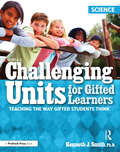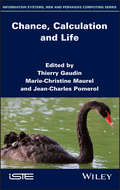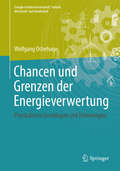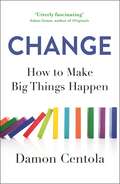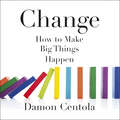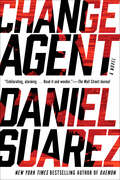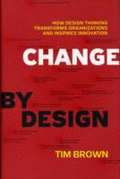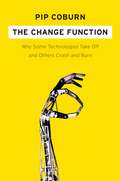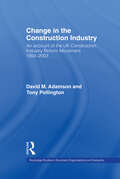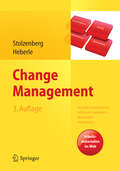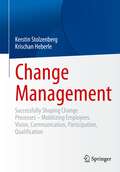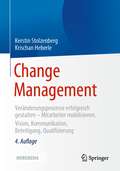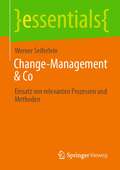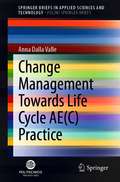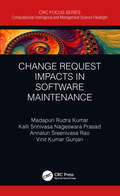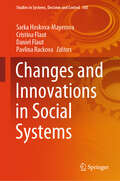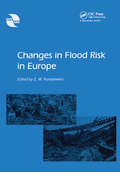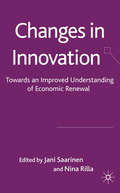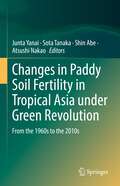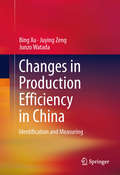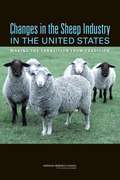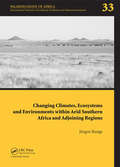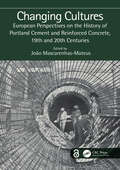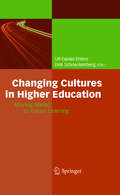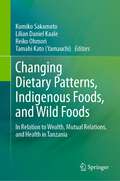- Table View
- List View
Challenging Units for Gifted Learners: Teaching the Way Gifted Students Think (Science, Grades 6-8)
by Kenneth J. SmithGifted students have the potential to learn material earlier and faster, to handle more abstraction, and to solve complex problems better. This potential, however, needs stimulating experiences from home and school or it will not unfold. These books are designed to help teachers provide the engaging curricula that will nurture this potential in school. The Science book includes a medical simulation in which teams of students work as doctors to diagnose patients' cases, a food science project in which students use a variety of information-gathering techniques to learn how nutrition impacts performance, a hands-on study of human memory and expertise, and a study of the physics of sports.Grades 6-8
Chance, Calculation and Life
by Thierry Gaudin Marie-Christine Maurel Jean-Charles PomerolChance, Calculation and Life brings together 16 original papers from the colloquium of the same name, organized by the International Cultural Center of Cerisy in 2019. From mathematics to the humanities and biology, there are many concepts and questions related to chance. What are the different types of chance? Does chance correspond to a lack of knowledge about the causes of events, or is there a truly intrinsic and irreducible chance? Does chance preside over our decisions? Does it govern evolution? Is it at the origin of life? What part do chance and necessity play in biology? This book answers these fundamental questions by bringing together the clear and richly documented contributions of mathematicians, physicists, biologists and philosophers who make this book an incomparable tool for work and reflection.
Chancen und Grenzen der Energieverwertung: Physikalische Grundlagen und Technologien (Energie in Naturwissenschaft, Technik, Wirtschaft und Gesellschaft)
by Wolfgang OsterhageIn diesem Band ist ein Gesamt-Überblick über den State-of-the-Art der Energiediskussion, eine Komplettdarstellung aller Technologien und deren physikalische Grundlagen für Praktiker und interessierte Leser mit Grundkenntnissen gegeben. Der erste Teil bietet eine Basis für alle Lesergruppen. Als Grundlagen der Energieverwertung werden Energiebilanzen, die durch die Hauptsätze der Thermodynamik bestimmt werden, atom- und kernphysikalische Vorgänge, sowie die Gesetze der Strömungsmechanik und des Elektromagnetismus vorgestellt. Die daraus resultierenden Technologien wie Dampfkraftanlagen, Solar- und Windenergie, Wasserkraft, Biomasse und Erdwärme werden erörtert. Schließlich erfolgt ein Ausblick auf zukunftsweisende Projekte wie Kernfusion, Brennstoffzelle. Smart-Energy-Konzepte, Geschäftsmodelle und Aspekte der Datensicherheit sind ebenfalls besprochen. Auf die Rolle von Energiebilanzen beim Climate Engineering wird abschließend eingegangen.
Change: How to Make Big Things Happen
by Damon Centola'A remarkable and important guide to effecting change in our individual lives, businesses, societies - and beyond' JONAH BERGER, bestselling author of ContagiousHow did movements like the Arab Spring and Black Lives Matter take off when they did? How did Lord Kitchener recruit 2,000,000 volunteers at the start of World War I?Why did Twitter take hold while Google+ has failed?What surprising lessons can we learn from Covid 19?From the spread of Covid-19 to the rise of political polarization, from implicit bias to genetically modified food, from NASA to Netflix - it's time to think differently about how change works.Professor Damon Centola is the world expert in the new science of networks. His ground-breaking research across areas as disparate as voting, health, technology and finance has highlighted powerful and highly effective new ways to ensure lasting change. In this book, Centola distils over a decade of deep experience into a fascinating new theory that challenges previous assumptions that new ideas are either contagious or not. Change shows that beliefs and behaviours are not transmitted from person to person in the simple way that a virus is. The real story of social change is more complex and much more interesting. When we are exposed to a new idea, our social networks guide our responses in striking and surprising ways. Drawing on deep-yet-accessible research and fascinating examples, Change presents a paradigm-shifting new science for understanding what drives change, recognising our blind spots and how we can change the world around us.
Change: How to Make Big Things Happen
by Damon CentolaHow do you change someone's mind? How do you stop bad habits? A bold new theory about the way ideas and behaviours spread (and can be altered) from the world's leading expert, Professor Damon CentolaHow did movements like the Arab Spring and Black Lives Matter take off when they did? How did Lord Kitchener recruit 2,000,000 volunteers at the start of World War I?Why did Twitter take hold while Google+ has failed?What surprising lessons can we learn from Covid 19?From the spread of Covid-19 to the rise of political polarization, from implicit bias to genetically modified food, from NASA to Netflix - it's time to think differently about how change works.Professor Damon Centola is the world expert in the new science of networks. His ground-breaking research across areas as disparate as voting, health, technology and finance has highlighted powerful and highly effective new ways to ensure lasting change. In this book, Centola distils over a decade of deep experience into a fascinating new theory that challenges previous assumptions that new ideas are either contagious or not. Change shows that beliefs and behaviours are not transmitted from person to person in the simple way that a virus is. The real story of social change is more complex and much more interesting. When we are exposed to a new idea, our social networks guide our responses in striking and surprising ways. Drawing on deep-yet-accessible research and fascinating examples, Change presents a paradigm-shifting new science for understanding what drives change, recognising our blind spots and how we can change the world around us.(P)2021 Hachette Audio
Change Agent: A Novel
by Daniel SuarezNew York Times bestselling author Daniel Suarez delivers an exhilarating sci-fi thriller exploring a potential future where CRISPR genetic editing allows the human species to control evolution itself.On a crowded train platform, Interpol agent Kenneth Durand feels the sting of a needle—and his transformation begins... In 2045 Kenneth Durand leads Interpol’s most effective team against genetic crime, hunting down black market labs that perform "vanity edits" on human embryos for a price. These illegal procedures augment embryos in ways that are rapidly accelerating human evolution—preying on human-trafficking victims to experiment and advance their technology. With the worlds of genetic crime and human trafficking converging, Durand and his fellow Interpol agents discover that one figure looms behind it all: Marcus Demang Wyckes, leader of a powerful and sophisticated cartel known as the Huli jing. But the Huli jing have identified Durand, too. After being forcibly dosed with a radical new change agent, Durand wakes from a coma weeks later to find he’s been genetically transformed into someone else—his most wanted suspect: Wyckes. Now a fugitive, pursued through the genetic underworld by his former colleagues and the police, Durand is determined to restore his original DNA by locating the source of the mysterious—and highly valuable—change agent. But Durand hasn’t anticipated just how difficult locating his enemy will be. With the technology to genetically edit the living, Wyckes and his Huli jing could be anyone and everyone—and they have plans to undermine identity itself.From the Hardcover edition.
Change by Design: How Design Thinking Transforms Organizations and Inspires Innovation
by Tim BrownThe myth of innovation is that brilliant ideas leap fully formed from the minds of geniuses. In reality, most innovations are borne from rigor and discipline.
The Change Function
by Pip CoburnThe ultimate guide to predicting winners and losers in high technology Pip Coburn became famous for writing some of the liveliest reports on Wall Street. He quoted everyone from Machiavelli to HAL, Anaïs Nin to Yoda, Einstein to Gandhi. But along with the quirky writing, he consistently delivered sharp insights into technology trends and helped investors pick stocks with long-term potential. After years of studying countless winners and losers, Coburn has come up with a simple idea that explains why some technologies become huge hits (iPods, DVD players, Netflix), but others never reach more than a tiny audience (Segways, video phones, tablet PCs). He says that people are only willing to change when the pain of their current situation outweighs the perceived pain of trying something new. In other words, technology demands a change in habits, and that's the leading cause of failure for countless cool inventions. Too many tech companies believe in "build it and they will come"-- build something better and people will beat a path to your door. But, as Coburn shows, most potential users are afraid of new technologies, and they need a really great reason to change. The Change Function is an irreverent look at how this pattern plays out in countless sectors, from computers to cell phones to digital TV recorders. It will be an invaluable book for people who create and invest in new technologies.
Change in the Construction Industry: An Account of the UK Construction Industry Reform Movement 1993-2003 (Routledge Studies in Business Organizations and Networks #Vol. 36)
by David M. Adamson Anthony H. PollingtonThe UK construction industry is the sixth largest industry in the UK in terms of turnover. During the last decade, it has undergone an unprecedented period of self-examination, including input from most of the leaders of the major suppliers and clients as well as from leading politicians, civil servants and political advisers. From 1993 to 2003, government and industry collaborated closely to achieve political and structural change in the industry and to bring about nothing less than a re-organization of the way it undertakes its business. This key text is an objective presentation of the critical issues inherent in the construction industry during this time. Providing invaluable source material for students of government/industry relations, industry practitioners and clients, and for economic and social commentators, this valuable resource draws on revealing personal accounts from politicians, civil servants, advisers and industry leaders, as well as factual reportage, archives and official papers of the period. Informative and enlightening, this book objectively details and documents exactly what happened at this time, and the reasons for it, and offers an unbiased interpretation of the successes or failures of the various initiatives that emerged, including the Movement for Innovation, Rethinking Construction and Constructing Excellence.
Change Management: Veränderungsprozesse erfolgreich gestalten - Mitarbeiter mobilisieren. Vision, Kommunikation, Beteiligung, Qualifizierung
by Kerstin Stolzenberg Krischan HeberleViele Veränderungsprojekte in Unternehmen scheitern daran, dass die erfolgskritische Frage des Change Managements ignoriert wird: Wie bindet man Mitarbeiter ein? In dem Buch zeigen erfahrene Organisationsentwickler die Bedeutung von Vision und Ziel, Kommunikation, Beteiligung und Qualifizierung für erfolgreiche Veränderungsprozesse. Die Autoren liefern konkrete Handlungsanleitungen, detailliert beschriebene Vorgehensweisen, Ablaufschemata, Gesprächsleitfäden und Checklisten. Die 3. Auflage wurde komplett überarbeitet und um weitere Tools ergänzt.
Change Management: Successfully Shaping Change Processes – Mobilizing Employees. Vision, Communication, Participation, Qualification
by Kerstin Stolzenberg Krischan HeberleViele Veränderungsprojekte in Unternehmen scheitern daran, dass die erfolgskritische Frage des Change Managements ignoriert wird: Wie bindet man Mitarbeiter ein? In dem Buch zeigen erfahrene Organisationsentwickler die Bedeutung von Vision und Ziel, Kommunikation, Beteiligung und Qualifizierung für erfolgreiche Veränderungsprozesse. Die Autoren liefern konkrete Handlungsanleitungen, detailliert beschriebene Vorgehensweisen, Ablaufschemata, Gesprächsleitfäden und Checklisten. Die 3. Auflage wurde komplett überarbeitet und um weitere Tools ergänzt.
Change Management: Veränderungsprozesse erfolgreich gestalten - Mitarbeiter mobilisieren. Vision, Kommunikation, Beteiligung, Qualifizierung
by Kerstin Stolzenberg Krischan HeberleViele Veränderungsprojekte in Unternehmen scheitern daran, dass die erfolgskritische Frage des Change Managements ignoriert wird: Wie bindet man Mitarbeiter ein? In dem Buch zeigen erfahrene Organisationsentwickler die Bedeutung von Vision und Ziel, Kommunikation, Beteiligung und Qualifizierung für erfolgreiche Veränderungsprozesse. Die Autoren liefern konkrete Handlungsanleitungen, detailliert beschriebene Vorgehensweisen, Ablaufschemata, Gesprächsleitfäden und Checklisten. Die 3. Auflage wurde komplett überarbeitet und um weitere Tools ergänzt.
Change-Management & Co: Einsatz von relevanten Prozessen und Methoden (essentials)
by Werner SeiferleinOrganisationen ändern sich nicht nur aufgrund neuerer Systeme, Prozesse oder neuer Organisationsstrukturen. Sie ändern sich, weil sich auch die Mitarbeiterinnen und Mitarbeiter innerhalb der Organisation anpassen und ändern. Nur wenn die Menschen darin ihre eigenen persönlichen Übergänge gemacht haben, kann eine Organisation wirklich von den Vorteilen des Wandels profitieren. Dieses Essential legt das Hauptaugenmerk auf Gesundheit und Wohlbefinden der Menschen in einem Unternehmen. Hierzu werden die planerisch beeinflussbaren gesundheitsrelevanten Faktoren betrachtet, die in einem Büro- bzw. Verwaltungsgebäude auf die Mitarbeiterinnen und Mitarbeiter wirken und deshalb in der Planung besondere Aufmerksamkeit benötigen. Will man sich kurz und knapp über das Thema Prozesse und Methode zur Implementierung von Wohlbefindlichkeit informieren, ist dieses Essential die geeignete Basis.
Change Management Towards Life Cycle AE (SpringerBriefs in Applied Sciences and Technology)
by Anna Dalla ValleThe book explores how architectural, engineering and construction (AEC) firms have been adapting and changing to effectively address key environmental challenges, focusing on Life Cycle Thinking and related methodologies (Life Cycle Assessments and Life Cycle Costing). Starting from current practice, the book outlines the necessary change management to turn into life cycle AE(C) practice, switching from a product-technology mindset to a life cycle thinking and holistic approach. Although the primary audience of the book are Architectural and Engineering firms, the broad range of topics encourages readers from different backgrounds to explore the latest advancements in construction sector. Service companies and software developers can find inspiration to develop innovative tools and solutions, clients can find ways to demand sustainability as key target for building design and universities can align academic programmes to address new industry challenges.
Change Request Impacts in Software Maintenance (Computational Intelligence and Management Science Paradigm)
by Madapuri Rudra Kumar Kalli Srinivasa Prasad Annaluri Sreenivasa Rao Vinit Kumar GunjanThis book discusses Change Management Impact Analysis and how this method is used to analysis the risks and benefits of a change management initiative when it pertains to obtaining critical insight into how the change management program budget should be allotted. The process also offers useful indicators for what areas within the system should be monitored during the change management process. This book presents theoretical analysis of practical implications and surveys, along with analysis. It covers the functions aimed at identifying various stakeholders associated with the software such as requirement component, design component, and class component. The book talks about the interrelationship between the change and the effects on the rest of the system and dives deeper to include the critical role that the analysis places on the existing multiple functions such as estimating the development costs, the project overhead costs, cost for the modification of the system, and system strength or detecting errors in the system during the process. Case studies are also included to help researchers and practitioners to absorb the material presented. This book is useful to graduate students, researchers, academicians, institutions, and professionals that interested in exploring the areas of Impact Analysis.
Changes and Innovations in Social Systems (Studies in Systems, Decision and Control #505)
by Sarka Hoskova-Mayerova Cristina Flaut Daniel Flaut Pavlina RackovaThis book presents challenges and innovations in social problems over the centuries. By their nature, human beings are innovative and continuously adapted to appeared changes over the time. From this point of view, human history can be considered as the story of all changes and innovations which have drastically influenced our way of life. Changes and innovations are normal things in the way of adaptation and are necessary conditions for survival along the time. Changes and innovations are hard and long-term processes. Any progress in history is the result of changes and innovations. To innovate, changes are required: in the culture, in the education, in the way of working, in the way of think, etc. In the same time, innovations imply changes, and changes usually generate reactions. Innovations are always oriented to the future and, in turn, imply changes. From here, the race of evolution was born. Changes require effort, generate resistance but, in the same time, increase performance in almost all domains, and increase vision and leadership; therefore, the progress is obtained. To grew up as a field and provide changes, innovations need to present its theoretical foundations which make sense of the domains on which they are applied. To emphasize the above aspects, the proposed book presents some aspects regarding, but not only limited, to: computer science (new theoretical and practical applications); mathematics (mathematical models, all mathematical results which can improve or are inspired from another known results, some aspects regarding history of mathematics, etc.); education, etc. The chapters of the book present the state of arts of the chosen subjects, from its beginning, its developments, and its applications, by emphasizing the connection with the application or model that the authors have chosen for the presentation.
Changes in Flood Risk in Europe
by Zbigniew W. KundzewiczThis book delivers a wealth of information on changes in flood risk in Europe, and considers causes for change. The temporal coverage is mostly focused on post-1900 events, reflecting the typical availability of data, but some information on earlier flood events is also included.
Changes in Innovation: Towards an Improved Understanding of Economic Renewal
by Jani Saarinen Nina RillaThis book is a collection of articles all contributing to the theme of changes in innovation and innovation processes, and aims to create new knowledge about crucial issues in the Finnish and global innovation environment which forms critical intelligence in innovation strategies for firms and decision makers.
Changes in Paddy Soil Fertility in Tropical Asia under Green Revolution: From the 1960s to the 2010s
by Junta Yanai Sota Tanaka Shin Abe Atsushi NakaoThis book investigates the effect of the Green Revolution (GR) on long-term changes in the fertility status of paddy soils in tropical Asia. While information on long-term changes in soil fertility status are rather limited due to difficulties in obtaining past data or samples for comparison, this investigation on temporal changes in soil fertility is possible by comparing fertility status in the 2010s, which the authors examined recently, with those from the 1960s, when GR was initiated, which was reported by Kawaguchi & Kyuma (1977). More than 220 paddy soils collected from Thailand, the Philippines, Malaysia, Bangladesh, and Indonesia were analyzed for their physicochemical properties as well as total and available fractions of plant macro- and micro- essential elements, and their temporal changes were examined in addition to their spatial variation in each country. The most significant change was a drastic increase of available phosphorus in soils, possibly due to fertilization after the GR. Changes in organic matter, pH, and other nutrients were relatively small. A considerable decrease in the content of some micronutrients was also observed. Long-term studies on soil fertility status in the past and present will be useful to establish soil/fertilizer management for sustainable rice production in the future. This book is an essential reading for soil scientists, agricultural scientists, environmental scientists, as well as policymakers and nongovernmental officers such as FAO.
Changes in Production Efficiency in China: Identification and Measuring
by Junzo Watada Bing Xu Juying ZengEvaluating Production Efficiency in China examines production from engineering and statistics perspectives rather than from economics and mathematics perspectives. The authors present an observable benchmark as the criterion of the production efficiency to replace the unobservable production frontier surface. This book discusses several different computing technologies, controllable variable as a path of identification, changes in production efficiency by decision making on specific operating conditions, and optimal resource allocation. The book provides a channel to tap inside the success stories of China, exploiting the way of changes in production efficiency during China's development in the past 30 years. This book examines the concepts and realization of production efficiencies across all areas of the economy. Also the book provides the perspective of foreign direct investment (FDI) absorption to identify how Chinese economy changes in production efficiency.
Changes in the Sheep Industry IN THE UNITED STATES: MAKING THE TRANSITION FROM TRADITION
by National Research Council of the National AcademiesThe U.S. sheep industry is complex, multifaceted, and rooted in history and tradition. The dominant feature of sheep production in the United States, and, thus, the focus of much producer and policy concern, has been the steady decline in sheep and lamb inventories since the mid-1940s. Although often described as “an industry in decline,” this report concludes that a better description of the current U.S. sheep industry is “an industry in transition.”
Changing Climates, Ecosystems and Environments within Arid Southern Africa and Adjoining Regions: Palaeoecology of Africa 33 (Palaeoecology of Africa)
by Jürgen RungeThis book is volume 33 of the yearbook seriesPalaeoecology of Africa presenting the outcome of atribute conference to the internationally recognized South African researcher and palynologist Professor Louis Scott. He has recently retired, but is continuing his active research career. The conference proceedings and articles published here
Changing Cultures: European Perspectives on the History of Portland Cement and Reinforced Concrete, 19th and 20th Centuries
by João Mascarenhas-MateusThe construction practices we employ in our daily life in European societies today were shaped by major changes in the past, such as the introduction and dissemination of Portland cement and reinforced concrete, a development that constitutes a fundamental chapter in the history of construction in the 19th and 20th centuries. Such changes were boosted by several innovations in the fields of applied mathematics, chemistry and physics. They involved patents licensing, optimization of materials production and machinery. There were new legislative frameworks, a specific knowledge transfer within a network of actors and the transformation of hierarchical frameworks. Written by international specialists, this two-part book is centred on case studies from the UK, Germany, Switzerland, France, Belgium, Portugal, Spain and Italy. The first part explores the mutual international influence between these countries and their intrinsic characteristics in this field, resulting from each nation’s particular economic, social, political, cultural and technological conditions. The second part focuses on the history of public works companies. Capable of carrying out both private works and major infrastructures, these players exemplify the technological and business advances that the construction sector has experienced over the last two centuries. This book is a must-read for researchers on contemporary construction history in Europe.
Changing Cultures in Higher Education: Moving Ahead to Future Learning
by Ulf-Daniel Ehlers Dirk SchneckenbergMore and more educational scenarios and learning landscapes are developed using blogs, wikis, podcasts and e-portfolios. Web 2.0 tools give learners more control, by allowing them to easily create, share or reuse their own learning materials, and these tools also enable social learning networks that bridge the border between formal and informal learning. However, practices of strategic innovation of universities, faculty development, assessment, evaluation and quality assurance have not fully accommodated these changes in technology and teaching. Ehlers and Schneckenberg present strategic approaches for innovation in universities. The contributions explore new models for developing and engaging faculty in technology-enhanced education, and they detail underlying reasons for why quality assessment and evaluation in new - and often informal - learning scenarios have to change. Their book is a practical guide for educators, aimed at answering these questions. It describes what E-learning 2.0 is, which basic elements of Web 2.0 it builds on, and how E-learning 2.0 differs from Learning 1.0. The book also details a number of quality methods and examples, such as self-assessment, peer-review, social recommendation, and peer-learning, using illustrative cases and giving practical recommendations. Overall, it offers a step-by-step guide for educators so that they can choose their own quality assurance or assessment methods, or develop their own evaluation methodology for specific learning scenarios. The book addresses everyone involved in higher education - university leaders, chief information officers, change and quality assurance managers, and faculty developers. Pedagogical advisers and consultants will find new insights and practices for the integration and management of novel learning technologies in higher education. The volume fosters in lecturers and teachers a sound understanding of the need and strategy for change, and it provides them with practical recommendations on competence and quality methodologies.
Changing Dietary Patterns, Indigenous Foods, and Wild Foods: In Relation to Wealth, Mutual Relations, and Health in Tanzania
by Kumiko Sakamoto Lilian Daniel Kaale Reiko Ohmori Tamahi KatoThis book presents different dietary patterns, some utilizing wild foods and others facing drastically changing dietary patterns, and shows their implications for health in terms of wealth, mutual assistance, food sufficiency and food diversity. The book examines these globally important issues through a case study of Tanzania. Using a novel methodology based on a global standard quality of life indicator, the book sheds light on the relationship between wild food intake and health in Tanzania. Descriptive case studies illustrate the impact of various food patterns and wild food intake on human health. It also highlights the divergence between food production sufficiency and food diversity. It then discusses the influence of wealth, mutual relations, and methods of food access. Finally, the book concludes with recommendations for maintaining good health in various environments. The intended readers of this book are academics and professionals in the fields of development, nutrition, and environment in East Africa. These include, but are not limited to, regional and district personnel who are actively engaged in development, relevant ministries of food and agriculture, and international organizations such as FAO, UNICEF, UNDP, and UNEP. In the academic field, students and researchers in international studies, development studies, African studies, social studies, cultural studies, nutrition, agriculture, and environmental studies are targeted.
